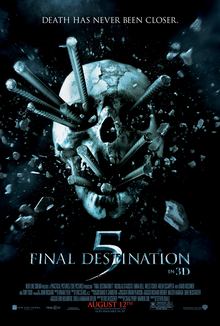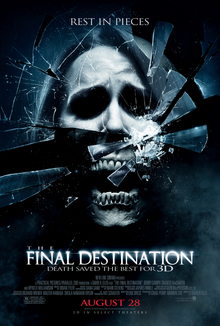The first four films of the Final Destination franchise have grossed an international $321million (adjusted for inflation)1. That figure exceeds 227% of its domestic take1. The significance of this is that in 2010 the North American box office tallied $10.5billion2 whereas the overseas numbers were $20b3. In an industry where the foreign market is worth 190% of the domestic the Final Destination franchise is an overachiever.
That begs the question why tinker with the formula? Why give a stripper a make over?
Jeffery Reddick wrote the Final Destination 2000 script as a staff writer for The X-Files. It was rejected but his TV colleagues James Wong (director) and Glen Morgan (writer) were impressed to join the project. So was New Line Cinema.
Reddick wrote the treatment and co-produced Final Destination 2 2003. Eric Bress penned the screenplay and David R Ellis directed. James Wong and Glen Morgan came back for Final Destination 3 2004. Ellis and Bress returned for The Final Destination 2009. These are the men who created and carried a horror franchise without an icon: without a Freddy, Jason, Michael Myers or Pinhead. They are the reason for its success.
 |
| Jeffery Reddick: discovered by New Line |
For whatever the reasons are New Line hired a new team for Final Destination 5 2011. Steven Quale4 is a first time feature director. He’s known as a James Cameron protégé having worked Second Unit on Avatar 2009 and Titanic 1997. That is good pedigree. It is negated by the hiring of screenwriter Eric Heisserer who wrote A Nightmare on Elm Street 2010. That screenplay is worse than the film.
The big gun New Line has for this movie isn’t creative – it’s technological. 3D pushed The Final Destination to a worldwide $193.6m (inflation adjusted) making it the highest grossing entry in the series. Furthermore worldwide revenue generated by 3D films doubled last year5. The technology is a hand-in-glove fit for the genre (as well as action, war and sci-fi). This is cinema as spectacle and the horror Fanboy will always seek a primal visceral satisfaction.
Cinema is not spectacle alone. The Fanboy demands to be told a story he has paid for. With A Nightmare on Elm Street 2010 Eric Heisserer has proved he couldn’t tell a story to a judge. Thus it is left to Quale to make a supermodel out of a swamp thing. It cannot be done. New Line will try – at a cost of $12 per ticket.
The story formula remains the same; the lead character has a premonition moments before a disaster strikes. He and others at his behest flee the scene and survive – so death returns to slay them one-b-one. In a departure from the previous films these survivors are neither school kids nor strangers. They are work colleagues in their early 20s and know each other outside the office: same difference.
The disaster as depicted in the trailer is one of the best in the franchise. Quale can shoot a set piece but Heisserer immediately includes narrative flaws. The eight survivors from Presage Paper are not the only survivors. This renders their predicament unexceptional. It goes against the ethos of the series. Somewhere in a parallel film other survivors are being stalked by death.
 |
| Nicholas D'Agosto: a case of casting disaster |
The casting for this film is particularly bad. The final boy is played by Nicholas D’Agosto. He performs each scene with a blank gawp. His best friend looks exactly like him except he wears a perpetual scowl. The girlfriend always looks like she’s about to cry and the peripheral victims seem to be waiting for roles they can include on their résumés. There is one name actor and Courtney B Vance should be ashamed of himself for accepting this role. His character adds nothing to the rote proceedings. It is only Tony Todd who delivers – both a creep factor and an assurance: this is still a horror film.
Or is it? Heisserer can’t write cohesive narrative and he certainly can’t write comedy. The scene in the Ming Yun Spa is the sort of racist humour the Nazis laughed at in the 30s. It’s to be seen how this film will play in Hong Kong.
The raison d’être for the franchise are the gags. As the movie wears on they become repetitive: there’s always something involving water and electricity. There is also the final gag. It’s an insult to the audience and the previous writers. Heisserer wrote The Thing 2011. It means he’s going to insult John Carpenter too.
The best part of this film is the opening credit sequence. Shirley Walker’s theme is gone but Brian Tyler provides an expectant replacement. This is telling because it means the next film will be the last one. Regardless of Final Destination 5 box office the public will be aware that 3D means less entertainment for more money.
Read more Thrill Fiction: John Carpenter’s TheWard
1 Final Destination franchise The Numbers
2 2010 domestic box office Variety
3 2010 international box office boxoffice.com
4 Steven Quale IMDb
5 3D global revenue TG Daily
Generated By Technorati Tag Generator





























